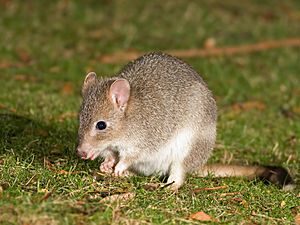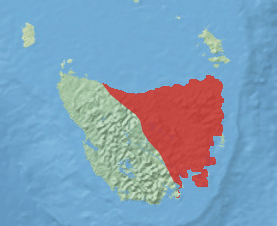Eastern bettong facts for kids
Quick facts for kids Eastern bettong |
|
|---|---|
 |
|
| Conservation status | |
| Scientific classification | |
| Genus: |
Bettongia
|
| Species: |
gaimardi
|
| Subspecies | |
|
Bettongia gaimardi cuniculus |
|
 |
|
| Present distribution of Bettongia gaimardi | |
The eastern bettong (Bettongia gaimardi), also known as the southern bettong or Tasmanian bettong, is a small marsupial that looks a bit like a kangaroo or wallaby. It lives in southeastern Australia and eastern Tasmania.
Types of Eastern Bettongs
There are two main types, or subspecies, of the eastern bettong.
- The mainland subspecies (B. g. gaimardi) used to live in mainland Australia.
- The Tasmanian subspecies (B. g. cuniculus) lives in Tasmania.
Sadly, the mainland bettong became extinct in the 1920s. This happened because new animals like the red fox and European rabbit were brought to Australia. These new animals caused problems for the bettongs. Luckily, the Tasmanian bettong still exists.
In 2012, a small group of eastern bettongs was brought back to the mainland. They were reintroduced in Canberra. This reintroduction was successful. More bettongs have been brought from Tasmania to help grow the population.
What They Eat and How They Live
Eastern bettongs live in dry, open eucalypt forests. They also like grassy woodlands. You can find them from sea level up to 1,000 meters high.
A big part of their diet is truffles and other underground fungi. They also eat roots and tubers. Sometimes, they munch on insects and grubs. It's amazing that these small creatures can travel far for food. They might go up to 1.5 kilometers from their home to find a meal.
Eastern bettongs are nocturnal animals. This means they are active at night. During the day, they sleep in a special domed nest. They build their nests using tightly woven grass, leaves, and shredded bark. They find safe spots like shallow dips in the ground. They also build nests under fallen logs or thick plants.
The bettong uses its curved prehensile tail to carry nesting materials. It's like having an extra hand! They only use a nest for a night or two. Then they move on to find new food sources.
Like other bettongs, they can have babies all year round. A baby bettong is called a "joey." The joey stays in its mother's pouch for about 105 days.
Dangers They Face
The mainland eastern bettong population died out in the 1920s. However, the Tasmanian population has been safe. One worry is that most bettongs live on private land. Only a few groups are found in protected areas.
Red foxes are a big danger to them. Because of these threats, the International Union for the Conservation of Nature has changed the eastern bettong's status. They are now considered "near threatened." This means they could become endangered if we don't protect them.
See also
 In Spanish: Canguro rata de Tasmania para niños
In Spanish: Canguro rata de Tasmania para niños


